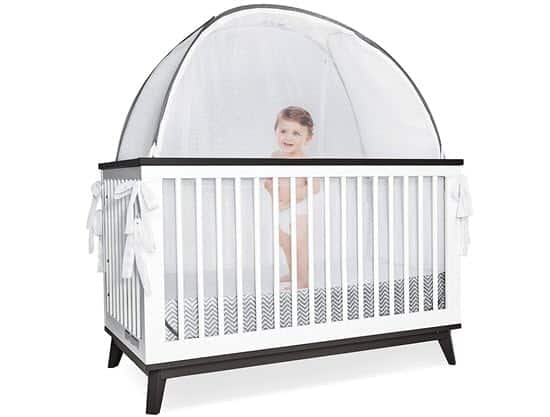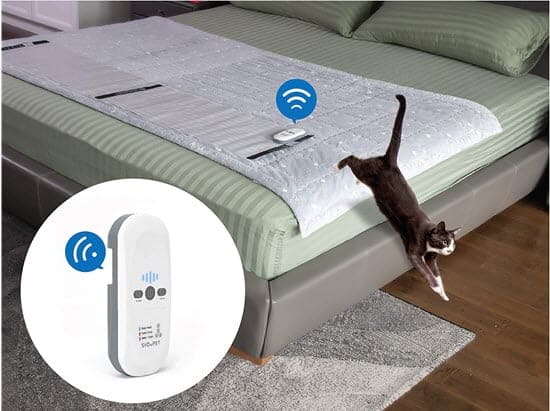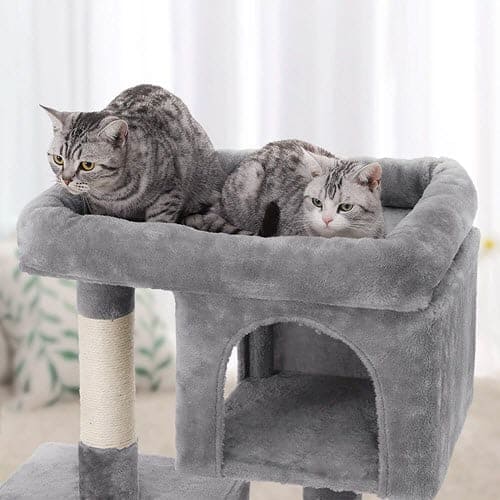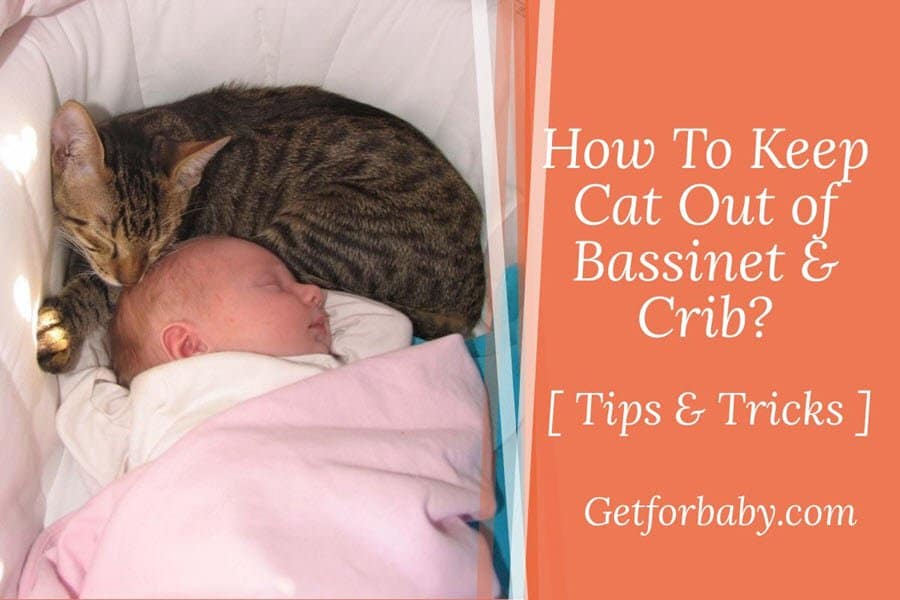Fact Checked By: Payal Mamotra
The presence of cats near the baby or inside the bassinet or crib is definitely not safe because infants are weak & vulnerable to diseases.
Their immune system is not well-developed, which means that even a house pet that is vaccinated & regularly groomed can be a source of danger for your newborn.
For example, a cat’s fur is very fine and pretty hard to detect on the baby’s bedding, especially if it’s almost the same color!
So, the danger of the baby swallowing cat hair is genuine and can prove life-threatening.
Also, bassinets are compact, sleek, and large enough to hold the baby’s weight up to 15-20 lbs. Any additional weight of a pet present in the bassinet increases the risk of the bassinet collapsing under pressure.
Another risk is the Cat jumping onto the baby. If your Cat tries to climb or jump onto the bassinet, it may topple it over, endangering your baby’s life.
Other potential Hazards are:
- Cats may accidentally suffocate newborns by lying too close to them.
- Newborns may develop cat dander, fur, or saliva allergies or can transmit diseases such as toxoplasmosis to newborns.
- Cats may scratch or bite newborns out of curiosity or territorial behavior.
- Cats may accidentally trap newborns in confined spaces or obstruct their movement.
- Cats may compete with newborns for attention from parents or caregivers.
- Changes in routine or environment due to the arrival of a newborn may stress cats.
It’s essential to keep the Cat out of the Bassinet and Crib Or away from your baby’s room for safety. So keep reading our “How To Keep Cat Out Of Bassinet and Crib” guide.
Table Of Content
How To Keep Cat Out Of Bassinet and Crib?
- Crib And Bassinet Cover For Cats:
- Train Your Pet To Don’t Sit In The Bassinet:
- Add Cat Furniture To The Baby’s Room:
- Keep Your Cat Active During The Day:
- Natural Cat Deterrents for Bassinets
- Use A Baby Monitor To Keep Watch:
How To Prevent Cats From Jumping In Baby Crib?
Why Do Cats Go In Baby Cribs?
How To Keep Cat Out Of Bassinet and Crib?
There are many ways to keep the Cat out of the bassinet and crib, such as using Aluminum Foil, double-sided tape, or a bassinet Cat Cover, Teaching them with a Pet Mat, or giving them a piece of separate furniture to sleep in the easiest and safest way.
But you don’t know which one works better for you, so let’s deep-dive into it to explore all these.
1.) Crib And Bassinet Cover For Cats:
Cat covers for Cribs and Bassinet are one of the easiest ways to keep the Cat out of them.

It not only keeps the Cat away from the bassinet but also prevents mosquitos and other bugs from entering it. The best thing about that crib cover for cats is that it can also be placed on top of Pack N Play to keep cats out of it, too.
The fabric used to craft these crib nets for cats is mesh, which easily lets fresh air in and maintains proper airflow.
There are many eCommerce stores where you can find cribs and bassinet covers. However, finding a suitable net that matches your baby’s nursery size is difficult. That’s why we have crafted a list of bassinet cat covers for you.
If you don’t want to cover the crib, training your pet to stay away from a newborn is the better option.
2.) Train Your Pet To Don’t Sit In The Bassinet:
Training pets is one of my favorite methods for keeping the Cat out of the bassinet and from other places such as the table, sofas, chair, kitchen, etc. But you must do this 1 – 2 weeks before the baby arrives home.

You need a Pet Training Mat, such as a DOG CARE Pet Shock Mat or SVDPET Pet Training Mat, to train your Cat to stay away from the crib.
Place this training mat in the crib or bassinet and let the Cat enter.
Once the Cat enters and puts pressure on the mat, it produces a harmless static pulse or a high-frequency beep to repel the Cat, which Cats hate.
In this way, you can teach the Cat that this is not a safe place to sleep.
I used it by placing the mat between the door to prevent the Cat from crossing the door, and it worked well. Now, my Cat does not even enter the room.
Using a cat pet mattress, you can teach the Cat not to jump on the table or dining table. Just place it a few days over the table, and your Cat will understand this is not the place for her.
But if you don’t want to use this training mat, you can cover your crib with Aluminum foil paper; as your Cat jumps on it, the sound will keep them at bay.
You can also use double side tap; Cats don’t like stickers or something they can touch or feel, so tape with two sides is a perfect thing to put around the sides of the bassinet or in the crib, where the Cat can’t get into.
Try the same trick a few times, and your Cat will remember this is not a place to sleep.
3.) Add Cat Furniture To The Baby’s Room:
Cats like their personal space, so instead of kicking your Cat out of your baby’s room, why not add new furniture for your Cat?

Cats like to laze about, and nothing is more inviting than a cozy bed. This is why cats love to sleep with newborn babies: Nothing is softer and cozier than a baby’s skin.
And that leads to suffocation and infant death when the Cat lies near the face of the baby.
So, having their own bed ( bassinet for a dog or Cat) will keep them from attempting to get in your baby’s bed.
This way, you can share the same room with the Cat and baby. Having its own furniture will let the Cat know precisely where it can and cannot go.
Not only do cats like a cozy place, but your infant also loves to sleep on a comfy surface. Try this guide: How to make Crib and Bassinet more comfortable?
4.) Keep Your Cat Active During The Day:
Cats can be moody and difficult to handle. Unlike dogs, cats may not always listen to you.

So, when you try to teach them to stay out of the baby’s room, things may not work out as planned. Because Cats are curious by nature, they may do quite the opposite.
Also, some owners consider the Cat a member of their family, so you may find it hard to force it to stay away or lock it up.
One way to keep your Cat out of the way is by keeping it busy throughout the Day. Giving your Cat a new Toy to play with in another room will keep it busy and prevent it from getting too curious about your newborn.
Rather than using a toy, I personally recommend using a Motion-Activated Cat Laser Toy, which is far better than traditional toys.
A few simple steps and a little bit of precaution can achieve the perfect balance between your baby and your Cat.
5.) Natural Cat Deterrents for Bassinets
Citrus oil is a perfect, authentic home remedy for keeping cats away from babies’ beds, while mint or rosemary oil can also be a deterrent.
Since the cats refuse the odor of citrus, peers and sprays with citrus smell can be used around their sleeping area to design a place they hate.
For example, cats tend to avoid rooms where they can detect a strong scent of mint or rosemary oil, which is not favorable for them. This prevents the baby from getting close to the sleeping baby.
You can realize this by entertaining such natural aromas in the vicinity so that the cats cannot access the bassinet or the crib. All these Natural Cat Deterrents keep your Cat away from newborns.
Besides, this step enables you to have a safe, cat-proof sleeping environment for your newborn.
6.) Use A Baby Monitor To Keep Watch:
This method is not as effective as others, but adding this to your infant nursery makes it safer and more sure and helps you track many different activities, too.

It doesn’t matter if I’m in the kitchen, home office, or even just the room next to my child’s room. I can monitor my little angel remotely.
My baby monitor shows me what my baby is doing and whether they are alone or not.
Cats, especially mine, are usually very quiet and sneak about the house quickly without being detected.
But by using a baby monitor, I can keep an eye on the baby’s nursery. Suppose you witness a disturbance through the monitor and need to intervene. In that case, you can rush into the baby’s room quickly. So it just gives you additional safety.
Cats can be challenging to handle and may not always listen to you, but this does not mean cats and babies cannot co-exist; just follow the safety measures.
I hope you liked our guide: “How To Keep Cat Out Of Crib And Bassinet?” Hopefully, it will help you.
Now, it’s your turn. Let me know which step you took to keep the Cat out of your crib. Let’s help other parents make their decisions quickly. Put your valuable feedback in the comment section.
And don’t forget to share the article because sharing is caring.
Some Important FAQ!
How To Prevent Cats From Jumping In Baby Crib?
You can follow one of these ways,
- Use aluminum foil to line the crib, as cats generally dislike the texture and sound of foil.
- Apply double-sided tape around the crib’s edges to create an uncomfortable surface for cats.
- Consider using deterrent mats that emit a mild static pulse when touched by the cat to discourage jumping
Why Do Cats Go In Baby Cribs?
As per the research and top forms,
- Cats attracted to the warmth and comfort of the crib, mainly if it’s located in a cozy spot.
- They also be curious about new surroundings and may explore the crib out of curiosity.
- Additionally, cats have a natural tendency to seek out elevated spots for observation and relaxation, making cribs an appealing choice.

Harvinder Singh
Senior Content Writer
Harvinder Singh is an engineer & certified project manager who founded Getforbaby to assist parents with their newborns. He inspired by his experiences with his nephews, Harvinder aims to simplify parenting by sharing his knowledge. Read More
We believe you should always know the source of the information you’re seeing.
- Cats.org.uk:- Cat and Babies
- Aspca.org:- Cats and babies
- pets.webmd.com:- newborn baby and cat safety
- Publications.aap.org:- Infant Death Due to Cat
- Healthline.com:- Introduce Cat with baby
- Battersea.org.uk:- Infants and cats
- Babycenter.com.au:- Keep Cat away
- Wikihow.com:- Keep Cat away
- Healthline.com:-Safety concerns when it comes to cats
Getforbaby editorial team is committed to providing the most helpful, updated & trustworthy parenting information. When creating or updating the existing content, we rely on credible sources, respected health organizations, to support the facts within our articles. Read Our Editorial Process.



HI!
Isn’t the Magic cat repellent just a rodent repellent that’s named Magic Cat because it mimics the cat behavior as in keeps rodents away? If you have any other info that shows it actually works on cats, i’d love to read as i am about to have a baby and at wits end about my husbands intrusive cat. Thank you
Hi Dea, Congratulations.
Well, as per my research and feedback that I get from other moms, it worked. By the way, Amazon has a return policy. So, Why not, you give it a try and check is that works as per your expectation or not.
you can also try: PetSafe Pawz Away Mini